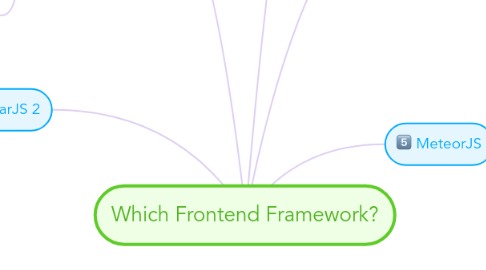
1. https://medium.com/@sachagreif/the-state-of-javascript-front-end-frameworks-1a2d8a61510#.s56gybf7r
2. React
2.1. Pros
2.1.1. Can be integrated easier into existing structure
2.1.2. We can migrate from Jquery to React
2.1.3. Virtual DOM (said to make for faster rendering and updating)
2.1.4. Backed by Facebook. Not going anywhere soon (is this such a good thing? :P ) (showing its efficiency within dynamic high-traffic applications)
2.1.5. Easy to extend into mobile apps (with ReactNative)
2.2. Cons
2.2.1. No application framework. We have to depend on external libraries for practically everything (components, lightboxes, etc)
2.2.2. Large size for "just" a library.
2.3. Features
2.3.1. Library (as opposed to framework)
2.3.2. ES5/ES6 based
2.3.3. Everything in the Javascript code approach
3. AngularJS 2
3.1. Pros
3.1.1. boasts the largest community of developers
3.1.2. Great documentation
3.1.3. two-way data binding (changes in the backend are immediately reflected on the UI)
3.1.4. Stable and not going to disappear soon
3.2. Cons
3.2.1. Steep learning curve
3.2.2. We have to launch a new frontend application in order to use this
3.2.3. Lots of overhead
3.3. Features
3.3.1. Full fledged framework
3.3.2. TypeScript based (type checking etc)
4. https://cdn-images-1.medium.com/max/800/1*ADuCd_GcORWlpCzTASmkxQ.png
5. Vue
5.1. Pros
5.1.1. is proved to be faster and leaner, comparing to React and Angular 2.0
5.1.2. two-way data binding (seen in AngularJS)
5.1.3. server-side rendering (like in Angular2 and ReactJS)
5.1.4. "takes the best from Ember, React and Angular"
5.2. Cons
5.2.1. Said to be very Chinese focused (developer is Chinese). Maybe this is changing??
5.3. Features
5.3.1. Library (as opposed to framework).
5.3.2. More comparible to React than the other 2
5.3.3. optional JSX support
5.3.4. Vue-cli (scaffolding tool for quick start)
6. EmberJS
6.1. Pros
6.1.1. Components can be created and reused. DRY is made very possible
6.1.2. Learning is very easy as it is pure javascript and handlebars
6.1.3. Comes with Babel.js by default
6.1.4. Very detailed documentation with a getting started guide as well as an API documentation
6.2. Cons
6.2.1. As it is a framework, we have to launch a new frontend application to use it
6.3. Features
6.3.1. Full fledged Framework
6.3.2. Pure Javascript
7. MeteorJS
7.1. Pros
7.1.1. full-stack platform enables fast development of end-to-end web and mobile applications
7.1.2. In terms of performance, all the changes in the database are immediately transmitted to the UI and in conversely with no evident time losses caused by different languages or server response time
7.2. Cons
7.2.1. doesn't support Windows phone
7.2.2. works well with MongoDB only
7.3. Features
7.3.1. Pure Javascript
7.3.2. built on top of NodeJS
